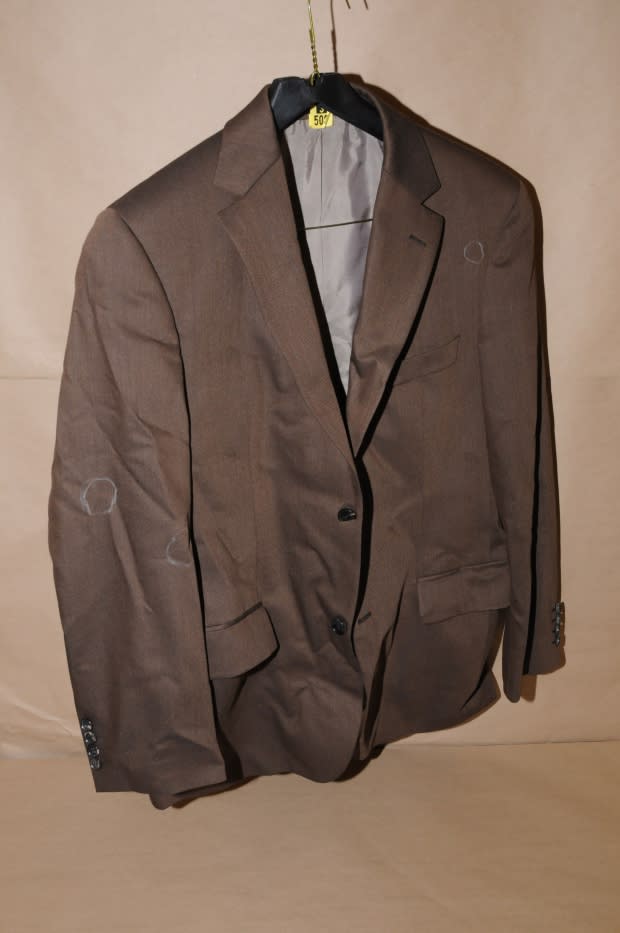Richard Oland was planning trip with mistress the day he was killed, murder trial hears
On the day Richard Oland was killed, he and his mistress, Diana Sedlacek, were planning a trip together, Dennis Oland's murder retrial heard Wednesday.
Text messages between the couple on July 6, 2011, show they planned to leave for Portland, Me., nine days later.
But the next morning, Oland's body was discovered face down in a pool of blood in his Saint John office. He had suffered 45 sharp- and blunt-force injuries to his head, neck and hands.
Dennis Oland was the last known person to have seen his father alive when he visited him at his office the night before.
Oland, 50, is being retried for second-degree murder in the bludgeoning death.
A jury found him guilty in December 2015, but the New Brunswick Court of Appeal overturned his conviction in October 2016 and ordered a new trial, citing an error in the trial judge's instructions to the jury.
The retrial is scheduled to resume Tuesday at 9:30 a.m. in Saint John Court of Queen's Bench.

On Wednesday, the court heard evidence from a digital forensics analyst with the RCMP. The Crown played a video of Neil Walker's testimony from the first trial.
Although Richard Oland's iPhone was never found, it had been backed up on his office computer, as of 4:41 p.m. on the day he was killed and disconnected three minutes later, Walker found.
He was able to extract the data, which included communications between Oland and Sedlacek, who were both married at the time.
Text messages
Walker read some of the text messages aloud at the request of Crown prosecutor Derek Weaver.
"Kisses. Snuggle me up I need your body," Sedlacek wrote on the evening of July 5, 2011. "Snuggle up kkk in bed," Oland replied.
The next morning, Sedlacek asked, "Did Zu find note? - re Our Trip."
"Have in [office]," he replied. The note, like the iPhone, was never found.

Dennis Oland did not approve of his 69-year-old father's extramarital affair, the court has heard.
He stopped by the multimillionaire's office around 5:35 p.m. that night to discuss genealogy and left about an hour later.
Walker found the "last human known interaction" on the victim's main computer was at 5:38 p.m., when the Firefox web browser was launched.
Defence lawyer Alan Gold argued there was no way to know how long the browser remained open, however, because closing it does not leave any traces. Walker was reluctant to answer definitively but agreed he was not aware of any.
Gold introduced additional iPhone communications extracted from the computer backup. They showed, in the days leading up to his death, Richard Oland would sometimes take hours to respond to Sedlacek. Walker agreed he was "not prompt" in responding.
"Richard Richard!!!!! It's 2 long now — Hate this waste of time!!!!" Sedlacek texted on July 4, 2011. "You're always wasting OUR time OUR life."

Earlier in the day, Gold, cross-examined Saint John Police Force forensic Const. David MacDonald about his role in the investigation.
MacDonald agreed the bloodstained brown sports jacket seized from Oland's home a week after his father was found dead should have been treated more carefully.
He said it was a mistake for then lead-investigator Const. Rick Russell to grab the jacket with an ungloved hand in identifying it to him as one of the items to be seized from Oland's bedroom closet because of the possibility of contamination of evidence.
MacDonald said he would have stopped Russell from touching the jacket with a bare hand if he had had an opportunity to do so.
He also acknowledged, in retrospect, that he would have handled seizing the jacket differently.
On Tuesday, MacDonald testified he had folded up the jacket and rolled it into a paper bag, measuring about 30 cm by 30 cm.
Gold argued this created the risk of trace evidence migrating from one part of the jacket to another. MacDonald agreed that was possible, but noted the jacket was a "dry exhibit."

Gold suggested that was "after the fact rationalization" and argued MacDonald doesn't know what effect stuffing the jacket into the small bag might have had.
The jacket is a key piece of evidence in the Crown's case against Oland. During opening statements Crown prosecutor Jill Knee said it had four areas of blood on it and DNA matching the victim's profile.
Oland told police he was wearing a navy blazer when he visited his father, but security video and witness testimony showed he was actually wearing a brown jacket.
The jacket and several other articles of clothing were dropped off to be dry cleaned or laundered the morning after Oland was questioned by police, the court has heard.
Stains on shirt, no blood on shoes

A blue and white checkered J. Crew dress shirt police believe Oland had been wearing during the visit was among the cleaned items.
MacDonald had found at least four faint red stains on the front of the shirt, a faded brown one on the lower left sleeve and a faded brown one on the inside of the right cuff, the court heard. But he agreed with Gold the RCMP forensic lab detected no human blood or human DNA.
Gold stressed the lack of evidence MacDonald found linking Oland to the homicide, despite the time and effort he put into photographing, examining and testing numerous items, such as the shoes Gold identified as being the ones his client was wearing that night.
He displayed several photos of the shoes on a large screen in the courtroom, pointing out the stitching and "canals" in the soles, suggesting there were "lots of little places … for trace evidence of blood to sit for the police to find." MacDonald told the court none was found.
Similarly, MacDonald analyzed Oland's BlackBerry, which had been used to send a text message at 6:12 p.m. on the night of the homicide and to receive a call at 6:36 p.m. Gold argued the cellphone also had lots of crevices for blood to get trapped. None was found, the court heard.

